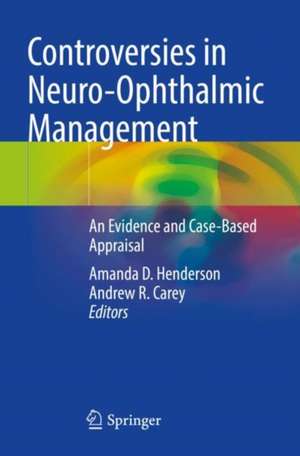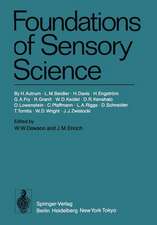Controversies in Neuro-Ophthalmic Management: An Evidence and Case-Based Appraisal
Editat de Amanda D. Henderson, Andrew R. Careyen Limba Engleză Paperback – 27 iun 2022
Divided into six sections, the book begins with an introduction to its framework, format, and purpose. Following this, sections two, three, and four discuss various optic neuropathies, ocular motility disorders, and transient visual symptoms. The concluding sections then address neuro-ophthalmic manifestations of pain, including migraine and post-concussive syndrome, and systemic diseases, such as giant cell arteritis. Each chapter focuses on cases that are historically complex, or which have undergone a recent shift in traditional management due to new scientific discoveries or newly available therapies.
Controversies in Neuro-Ophthalmic Management presents essential, thorough information on management options and the data for their use to provide the best care for patients.
Toate formatele și edițiile
| Toate formatele și edițiile | Preț | Express |
|---|---|---|
| Paperback (1) | 658.50 lei 38-45 zile | |
| Springer International Publishing – 27 iun 2022 | 658.50 lei 38-45 zile | |
| Hardback (1) | 974.97 lei 38-45 zile | |
| Springer International Publishing – 26 iun 2021 | 974.97 lei 38-45 zile |
Preț: 658.50 lei
Preț vechi: 693.16 lei
-5% Nou
Puncte Express: 988
Preț estimativ în valută:
126.00€ • 131.56$ • 104.28£
126.00€ • 131.56$ • 104.28£
Carte tipărită la comandă
Livrare economică 31 martie-07 aprilie
Preluare comenzi: 021 569.72.76
Specificații
ISBN-13: 9783030741051
ISBN-10: 3030741052
Pagini: 288
Ilustrații: VIII, 288 p. 41 illus., 17 illus. in color.
Dimensiuni: 155 x 235 x 15 mm
Greutate: 0.54 kg
Ediția:1st ed. 2021
Editura: Springer International Publishing
Colecția Springer
Locul publicării:Cham, Switzerland
ISBN-10: 3030741052
Pagini: 288
Ilustrații: VIII, 288 p. 41 illus., 17 illus. in color.
Dimensiuni: 155 x 235 x 15 mm
Greutate: 0.54 kg
Ediția:1st ed. 2021
Editura: Springer International Publishing
Colecția Springer
Locul publicării:Cham, Switzerland
Cuprins
I. Introduction.- 1. Purpose of this Book.- II. Optic neuropathies.- 2. Non-arteritic anterior ischemic optic neuropathy.- 3. Radiation optic neuropathy.- 4. Optic neuritis.- 5.Traumatic optic neuropathy.- 6. Papilledema.- 7. Leukemic infiltration of the optic nerve.- 8. Infectious optic neuropathy.- 9. Hereditary optic neuropathy.- 10. Compressive optic neuropathy.- III. Ocular motility disorders.- 11. Transient diplopia.- 12. Third nerve palsy.- 13. Sixth nerve palsy.- 14. Fourth nerve palsy.- 15. Multiple cranial neuropathies.- 16. Nystagmus.- IV. Transient visual symptoms.- 17. Transient monocular vision loss.- 18. Transient binocular vision loss.- 19. Visual aura.- V. Pain.- 20. Migraine.- 21. Trigeminal autonomic cephalgia headaches.- 22. Post-concussive syndrome.- VI. Systemic disease.- 23. Giant cell arteritis.- 24. Myasthenia gravis.-25. ophthalmopathy.- 26. Sarcoidosis.
Notă biografică
Amanda D. Henderson, MD
Johns Hopkins Wilmer Eye Institute
Dr. Henderson is an Assistant Professor of Ophthalmology and Neurology in the division of Neuro-Ophthalmology at the Wilmer Eye Institute at Johns Hopkins. She attended medical school at Emory University, completed an ophthalmology residency at the Medical College of Georgia, and completed a fellowship in neuro-ophthalmology at the Bascom Palmer Eye Institute.
Her research focuses on optic neuropathies, specifically non-arteritic anterior ischemic optic neuropathy. She also has a particular interest in medical education and is the Neuro-Ophthalmology Fellowship Director, Associate Ophthalmology Residency Program Director, and Education Champion for the division of Neuro-Ophthalmology at Wilmer.
Andrew R. Carey, MD
Johns Hopkins Wilmer Eye Institute
Andrew R. Carey, MD is an Assistant Professor of Ophthalmology in the division of Neuro-Ophthalmology at the Wilmer Eye Institute. He specializes in neuro-ophthalmic disorders such as optic neuritis, uveitis related papillitis, ischemic & hereditary optic neuropathies as well as diseases of the retina, including age-related macular degeneration, diabetic retinopathy, toxic retinopathies and inherited disorders of the retina such as retinitis pigmentosa.
Dr. Carey’s clinical and research interests include comparative effectiveness and cost-benefit of intravitreal medications, long-term outcome of treatments for choroidal neovascularization, novel treatments for papillitis, and the use of novel imaging modalities to better diagnose and understand optic nerve and retinal diseases.
Dr. Carey received his bachelor's from Davidson College in mathematics in 2006. In 2010, he received his medical degree from the University of South Florida. He completed his ophthalmology residency as Chief Resident in 2014 at the University of South Florida. He then went on to complete his fellowship in neuro-ophthalmology at Bascom Palmer Eye Institute in 2015 and his fellowship in medical retina at the University of Iowa in 2016.
Textul de pe ultima copertă
This book functions as a resource for providers who treat patients with neuro-ophthalmic conditions. Using an evidence-based approach to controversial management decisions, the material is presented in a digestible, case-based format.
Divided into six sections, the book begins with an introduction to its framework, format, and purpose. Following this, sections two, three, and four discuss various optic neuropathies, ocular motility disorders, and transient visual symptoms. The concluding sections then address neuro-ophthalmic manifestations of pain, including migraine and post-concussive syndrome, and systemic diseases, such as giant cell arteritis. Each chapter focuses on cases that are historically complex, or which have undergone a recent shift in traditional management due to new scientific discoveries or newly available therapies.
Controversies in Neuro-Ophthalmic Management presents essential, thorough information on management options and the data for their use to provide the best care for patients.
Divided into six sections, the book begins with an introduction to its framework, format, and purpose. Following this, sections two, three, and four discuss various optic neuropathies, ocular motility disorders, and transient visual symptoms. The concluding sections then address neuro-ophthalmic manifestations of pain, including migraine and post-concussive syndrome, and systemic diseases, such as giant cell arteritis. Each chapter focuses on cases that are historically complex, or which have undergone a recent shift in traditional management due to new scientific discoveries or newly available therapies.
Controversies in Neuro-Ophthalmic Management presents essential, thorough information on management options and the data for their use to provide the best care for patients.
Caracteristici
Features evidence-based case studies in neuro-opthalmic management Written by experts in the field of neuro-ophthalmology Provides a resource for optometrists, comprehensive ophthalmologists, neuro-ophthalmologists, as well as resident and fellows in training























